
Blackman and White’s new routing heads allow for the router shank size to increase from 6mm to 8mm, enabling processing of thicker materials at higher cutting speeds
With increasing interest in traditional and heritage style signage
alongside, and sometimes in combination with, modern relief styling, the
demand for 3D signs is growing significantly and, along with it, the
demand for production machinery that can not only create the right
effects for single pieces but efficiently and accurately produce
multiple items. A key piece of equipment in this quest for quality is
the router, and manufacturers are developing ever more innovative and
sophisticated machines to meet market needs.
Shaping up
Although they have been well established for many decades as a standard
item in industrial manufacturing, CNC routers have now come into their
own in the sign-making industry too, with specific machines being
developed for this sector.
Complete CNC Solutions has recently announced the launch of the new
Protek Unico CNC, a dedicated production router that is targeted at
companies with big routing production workloads or those that plan to
grow their businesses to that stage. According to Julian Sage, Complete
CNC Solutions’ managing director, the new system is brilliantly
qualified as a production router and will exceed expectations among
customers who need endurance and capacity.
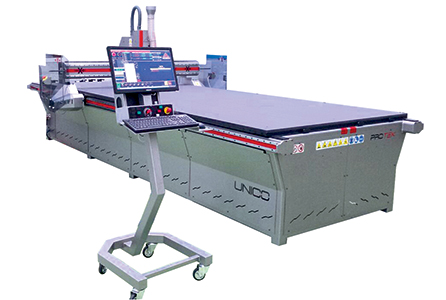
The Unico CNC from Complete CNC Solutions is a
dedicated production router that is targeted at companies with big
routing production workloads
The new system is classed as a next generation production router. Sage
says: “It combines over-specified and heavily engineered components with
a state-of-the-art control system. The result is truly exceptional
output, finished to the extent it comes off the bed ready to use. It’s
also a system that’s easy to use with versatility on tap; the benefit to
customers of making output that’s ready to use rather than ready for
manual finishing is inestimable.”

The result is truly exceptional output, finished to the extent it comes off the bed ready to use”
The many features of the Unico CNC include a bed that is designed to
provision extremely powerful vacuum hold over workpieces and a waste
extraction system that copes with difficult cutting by-products that can
cause choking and bring production to a dusty and costly halt.
The Unico CNC also features a powerful spindle, auto tool changer, and a
material flatness sensor in addition to a camera for cutting output in
tight register. Knife cutting is optional.
Sage explains the new system’s role: “The new Protek Unico CNC sits
alongside the 2016 Unico TT digital cutter and offers itself as a go-to
solution to companies looking for relentless production but in a
thoroughly up-to-date context. The system offers a degree of control and
quality of output that’s totally alien in the world of traditional
routing production hardware. We’re delighted to offer the Unico CNC to a
demanding market and we feel it rounds out the Protek portfolio
brilliantly.”
Trotec’s marketing manager, Lucy Hall, comments: “As one of our key
customer bases, Trotec is well versed in the requirements of both modern
day and traditional sign makers. So, last year we were proud to unveil
the newest addition to the Speedy line of laser engravers, the
innovative Speedy 360.”
With a working area of 32 x 20" (813 x 508mm), the Speedy 360's bed size
has been designed to maximise the material usage of standard sheets of
laminates, acrylic, and other popular sign-making materials. Developed
with productivity, flexibility, and usability in mind, the Speedy 360
incorporates a brand new focus mode featuring Sonar TechnologyTM.
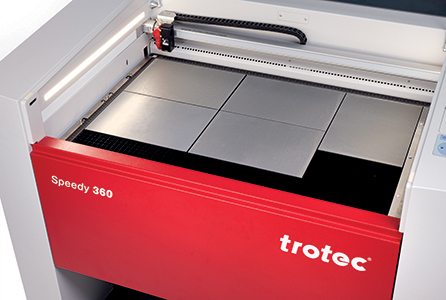
The Trotec Speedy 360’s 32 x 20” bed size has been
designed to maximise the material usage of standard sheets of laminates,
acrylic, and other popular sign-making materials
“Sonar TechnologyTM, based on ultra-sonic sensors, provides the highest
level of accuracy, ensuring precise engraving results,” Hall explains.
Meanwhile, at the opposite end of the spectrum Trotec's large-format
SP1500, which also launched in the UK last year, is suited to a full
standard sheet size of acrylic, with a working area of 1500 x 1250mm. In
addition, the optional heavy load table allows users to process objects
weighing up to 50kg, which significantly broadens the possibilities of
what can now be laser engraved and cut.
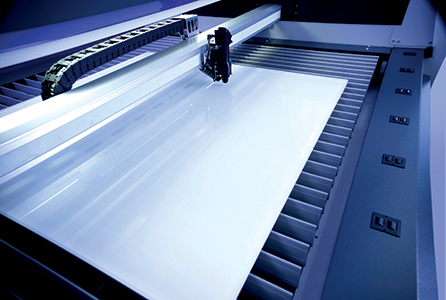
Trotec’s large-format SP1500 features a working area
of 1,500 x 1,250mm, suitable for handling a full standard sheet size of
acrylic
HPC Laser is experiencing continuous growth in the sign-making industry
as CNC routers are often seen as an affordable option for many
customers, as the quick and easy process and versatility of CNC machines
allows users to cut and engrave complex shapes and sizes on almost any
materials.
“The greatest advantage of using a CNC Router is cutting depth,
repeatability, and accurately, meaning that any vector file can be cut
precisely over and over again,” observes Chris Jacobs, managing director
at HPC Laser.
HPC’s fully computer controlled machines are loaded with software
capable of storing a number of files from most CADCAM packages such as
Coreldraw, Autocad, and Adobe Illustrator. “Not only does this make
laser cutting more efficient, it requires less man power to make a large
sign,” Jacobs adds.
HPC Laser has recently developed a series of flatbed CNC Router machines with a work area of up to 3 x 2m.
“We’re incredibly excited about our newest routing heads, which allow
for the router shank size to increase from 6mm to 8mm. This enables
processing of thicker materials at higher cut speeds—a massive advantage
for our customers and their clients,” says Blackman and White’s
managing director, Alex White.
He goes on to explain that the power of Blackman and White’s router is
also being increased from 2.5kw up to nearly 4kw, with the power levels
sustainable over extended periods of production due to it being water
cooled by means of a water chiller.
“These improvements are excellent for sign-makers in particular, who
rely on high precision and extremely smooth processing of Bezier curves
for true type fonts and other graphic displays,” White continues,
adding: “Our high rpm and strong cutters allow for much tighter control
when cutting with high speeds and accelerations.”
For processing of printed graphics, Blackman and White’s new ‘Tiger’
vision software is being used for production applications which have
printed registration marks that require the use of a camera to position
the job accurately. As more demanding applications for 3D contour
milling become necessary for customers the company recommends SignLab
and AlphaCam as good choices.
White continues: “I think that 3D printing may eventually start to
reduce the need for routing applications. However, the price and speed
of 3D printing needs to become a lot more attractive for this to take
effect.
“Sign and print applications continue to increase as digital printers
become cheaper and faster, so for the next five years I see routing
applications increasing, which makes an investment in in-house finishing
well worthwhile. From the optimisation of bed sizes to the sheer size
of flatbed lasers which maintain their high speeds, the developments in
laser technology provide a multitude of benefits for sign makers.”
Carving a new path
Sign-making operations come in all sizes and the sheer physical
challenge of fitting all the machinery required for sign production into
a small workshop can be daunting, often making it impossible for
sign-makers to diversify in order to meet the demands of their
customers. With this in mind, equipment manufacturers have started to
introduce multiple task machines that provide quality output as well as
reducing the space needed for these operations.
A recent development introduced by Complete CNC Solutions heralds a
re-division of traditional boundaries drawn between lightweight flatbed
plotters or ‘digital cutters’ and powerful routers. The Protek Unico TT,
in particular the latest 2016 variant, is a single device capable of
doing the work of either class of machine. The company describes the
Unico TT as being ‘a potent and very versatile digital cutter and an
equally well qualified router’. It has a range of static and oscillating
knives, v-cutters and incising tools, creasing blades and wheels
dedicated to a twin tool bay on its substantial tool carriage. Next to
the bay is a very powerful routing spindle served by a fully automatic
tool changer.
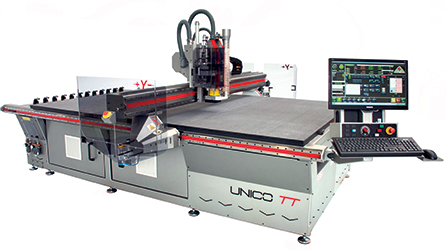
The Protek Unico TT from Complete CNC Solutions offers
both cutting and routing in a single machine, featuring a range of
static and oscillating knives, v-cutters and incising tools, creasing
blades and wheels
“With this single machine, a user can despatch any and all of the work
he’d expect to undertake on a digital cutter, and power through
practically any routing task needed too. The one machine is capable of
churning through work that is beyond the capability and capacity of a
traditional digital cutter,” enthuses Complete CNC Solutions’ Sage.
He continues: “Among the many benefits of using such an advanced system
beyond its sheer versatility is its extraordinary quality. Routed output
is of benchmark-setting finished quality right off the bed. Print
finishing and knife cut output is in tight and consistent register. It
can even compensate for continual variation in material thickness.
“We have here what we’re often told is the world’s most versatile
digital cutter and routing system for those in need of print finishing
and advanced knife cutting in addition to powerful routing; and on the
other hand, in the Unico CNC we have a totally focused out-and-out
production router. Both have Protek on the label.”
AXYZ International is also responding to new markets and one of its most
important recent developments has been the launch of the hybrid AXYZ
Trident print finishing machine.
Robert Marshall, AXYZ International vice president (market development),
explains: “Sign manufacturers are now venturing into new markets and
digital print finishers are being asked to process a much wider range of
both flexible and rigid materials. These invariably require longer,
wider and deeper routing/cutting capabilities that traditional routers
would find difficult to accommodate.”

Sign manufacturers are now venturing into new markets and digital
print finishers are being asked to process a much wider range of both
flexible and rigid materials”
The AXYZ Trident incorporates a three-head routing/cutting
configuration, incorporating a CNC routing spindle, and oscillating and
tangential knife units that are interchangeable to accommodate both
frequently problematical thin materials like vinyl, cardboard, and
paper, and thicker and heavier materials such as non-ferrous metals,
acrylic, aluminium composite materials (ACM), and foamed board.
The company says in comparison with other AXYZ routers, the Trident can
increase throughput by as much as 50 percent. It also features a
narrower carriage that contributes to a twelve percent smaller
footprint, whilst obviating the need to purchase two separate machines
to carry out all of the routing, creasing, and cutting requirements of
digital print finishing.
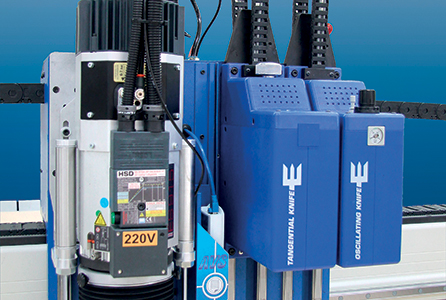
AXYZ International’s Trident hybrid print finishing machine incorporates a three-head routing/cutting configuration
The first UK installation of a Trident 6010 took place recently at
Hampshire-based Key2 Group. Managing director, Mike Keating, comments:
“As an existing customer of AXYZ International, we were well aware of
the versatility and scope of its machines. We chose the AXYZ Trident
6010 because it is far quicker, cleaner, and quieter than any previous
generation of machine and because it enables us to handle a much wider
range of both rigid and flexible materials. Due to its versatility, the
machine has also enabled us to venture into new markets such as
packaging.”
O Factoid: The first NC machines were built in the 1940s and 1950s, based on existing tools that were modified with motors that moved the controls to follow points fed into the system on punched tape. O
Versatility is definitely the word in terms of both sign manufacturing
and production equipment; and it appears machinery manufacturers are
clearly addressing those needs, resulting in a wide range of choices for
sign-makers.
So, whether you need the capacity to produce large or small, one-off or
multiple runs of 3D signage, there will almost certainly be a machine to
fit your needs and the size of your workshop.
Your text here...Your text here...